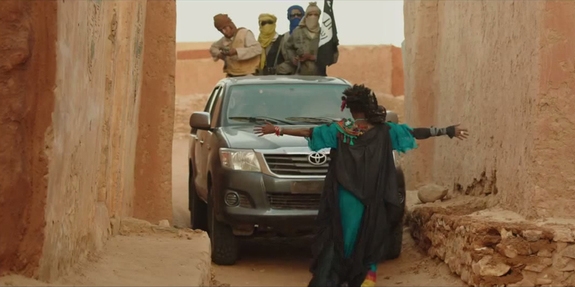The movie ‘Timbuktu’, that deals with fundamentalist terror, deserves the Oscar.
‘Timbuktu, Le chagrin des oiseaux ‘ (‘the sadness of birds’) by Mauritanian-born and Mali-raised Abderrahmane Sissako (53), is a superb film about the kidnapping of a society by Islamic fundamentalism. It also has a high degree of urgency.
The story takes place in northern Mali, not long after June 2012, when the radical Islamic group Al-Qaida au Maghreb Islamique (AQMI) and Ansar Eddine chased the Tuareg independence movement MNLA out of, and in turn occupied, the ancient desert city of Timbuktu.
Sissako's earlier films also dealt with subjects that matter. 'Heremakono' (2002) was about emigration and 'Bamako' (2006) showed the disastrous impact of the World Bank on the lives of ordinary Malians. Sissako takes his role as a filmmaker very seriously. He hails from a part of the world that produces few films and is, perhaps therefore, committed to directing movies he feels he has to make.
The release of a new type of iPhone on that day received more publicity
This was certainly the case with ‘Timbuktu’. Sissako could not bear the lack of attention paid to the suffering of the Muslim population caused by the jihadists’ invasion in the north of the country where he grew up. The immediate trigger for the movie was the stoning by Al-Qaïda fighters of the parents of two young children, because they were not married, in the village of Aguelhok on July 29, 2012. The release of a new type of iPhone on that day received more publicity.
Hunted prey
'Timbuktu' begins and ends with hunted prey. The first few shots show a gazelle running for its life, chased by men in four-wheel drives. Immediately after this scene we see wooden masks and sculptures being destroyed by bullets. Then follows a brief scene showing a white hostage being unloaded from a jeep. But the main issue, to Sissako, are not the masks, nor the hostage. He has emphasized in an interview that an entire religion and a whole society have been held hostage here.
International media have focused on the destruction of the tombs of Sufi saints; the threat of same in the case of the ancient manuscripts stored in Timbuktu; and the fate of the Western victims of Islamic-fundamentalist terror. This film describes the fate of the local population. It was filmed in neighbouring Mauritania, that offered Sissako the protection of its army on the film sets in Oualata and Nema.
The market woman refuses to wear gloves when selling fish
In beautiful, slow, panoramic images that contain the landscape and the characters, Sissako sketches through loose, brief scenes how daily life in the desert city and its surroundings changed with the arrival of the jihadists. They come from outside, from Libya for example; they speak Arabic, English and French, while the local population speaks Bambara and Tamasheq (the language of the Tuareg). There is a constant need for translation. Smoking, making music, playing football are prohibited and Sharia is introduced. Sissako prepared for his film talking to residents of Timbuktu about their experiences. This resulted, for example, in a true scene about a market woman who refuses to wear gloves when selling fish.
Women bear the brunt of the invasion. They are forced to cover up completely and are married off against their will. One evening, as jihadists patrol the rooftops, there are sounds of music from a house. A woman - played by Fatoumata Diawara- sings a beautiful song whilst lying on a couch. She is sentenced to caning, during which punishment she continues to sing.
Absurd rules
The local imam asks the jihadists what they are doing; where is God in all this? Residents oppose the absurd rules and even the jihadists themselves have difficulty adhering to their own laws. A video recording in which a former rapper talks of his conversion fails because he simply doesn’t come across as credible. Secretly, the invaders smoke and, though soccer is not allowed, discuss the merits of soccer star Zidane. In one of the most beautiful scenes, children play a game of football without the ball; it becomes almost a dance.
There is more dancing in the film. A gruesome image of a stoning is immediately followed by a dreamlike scene where a jihadist performs a silent choreography in the yard of a character called the ‘crazy woman’. This woman is left unbothered. Talking gibberish, dressed in a colourful robe with a long train and a rooster on her shoulder, she is even able to bring a jeep to a halt. Female characters such as this one appear more commonly in West African films. Being out of order, such a woman represents freedom and the right to be different. She is sometimes clairvoyant; sometimes she is a queen.
The images of a running Toya symbolise the devastation
Through all the scenes, the central story is that of a Tuareg nomadic family. Kidane, his wife Satima and their daughter Toya have pitched their tent just outside the city. The threat is subtly constructed: Satima is harrassed by a jihadist who has a crush on her. She wants the family to leave, like their neighbours have done before, but her husband does not want to yield to terror. When their favourite cow, called GPS, is slain by a Bozo fisherman, the drama unfolds.
The film ends again with hunted prey –but this time, the prey are people. The last, penetrating, images of a running Toya symbolise the devastation wrought by the fundamentalists.
The film has been a success in the French cinemas and is rightly in the running for an Oscar for best foreign film.
Elvire Eijkman works as an information specialist at the Library of the African Studies Centre in Leiden. She is responsible for acquisitions and collection development policy with a special focus on French-speaking Africa and movies.


